When it’s healthy and the growing conditions are optimal, you can pretty much leave grass to get on with growing – no interventions needed.
So if you’ve noticed that a patch of your lawn, or even your full lawn, isn’t growing, you might be wondering what’s going on.
In this guide, I’ve shared the 11 most likely reasons why your grass isn’t growing – and, importantly, what you can do about it.
✅Key Takeaways:
If your existing lawn isn’t growing, you could have issues with light and water access, compacted soil, weeds and moss, a lack of nutrients, or cutting your grass too often/not enough.
If you’ve planted new grass seed that isn’t growing, there could be problems with the soil preparation, planting depth, watering, seed quality, planting time, fertiliser, soil pH, competing weeds, and more.
Table of Contents
🤷♂️ Why Isn’t My Existing Grass Growing? 7 Causes And Solutions
Here, I’ve shared the 7 most common reasons why the existing grass on your lawn might not be growing.
☀️ Issue 1: Your Lawn Doesn’t Get Enough Light
If you have a shaded lawn, it’s possible that the grass doesn’t get enough light for you to establish a healthy lawn.
Light, along with nutrients and water, are essential to grass growth. Grass in the shade is often weaker than grass in sunlight and will eventually turn yellow and die.
How To Resolve:
I know that there’s probably not a lot you can do about shade – part of my lawn is in shade due to the shadow of my own home, and there’s nothing I can do to change that.
However, you can prevent grass plants from struggling to thrive due to a lack of sunlight by choosing a type of seed that’s tolerant to shade. I’ve tested various grass seeds for shaded areas over the past few years, and you can find my current top pick in my guide to the best grass seed for shaded lawns.
💦 Issue 2: Inadequate Watering
Another reason why your grass seed might not grow is if you don’t water it as much as it needs – or at all.
Watering your grass seed sufficiently and consistently is crucial if you want the seeds to germinate. The seeds will struggle to sprout in very dry soil. But that doesn’t mean that excessive watering is the answer, either – overwatering can lead to seed rot or shallow root development, which also disrupts new growth. You have to find the right balance!
How To Resolve:
Make sure to adapt a good watering routine to encourage new seed growth without under- or over-watering.
Water the overseeded areas immediately after seeding, then water your lawn once or twice per day for the next 3-4 weeks. No need to water if it’s already raining – you don’t want to overwater. Equally, avoid very shallow watering, which might under-supply the grass seeds with the water they need.
Check out my guide on how to seed a lawn for specific advice on watering and other useful tips.
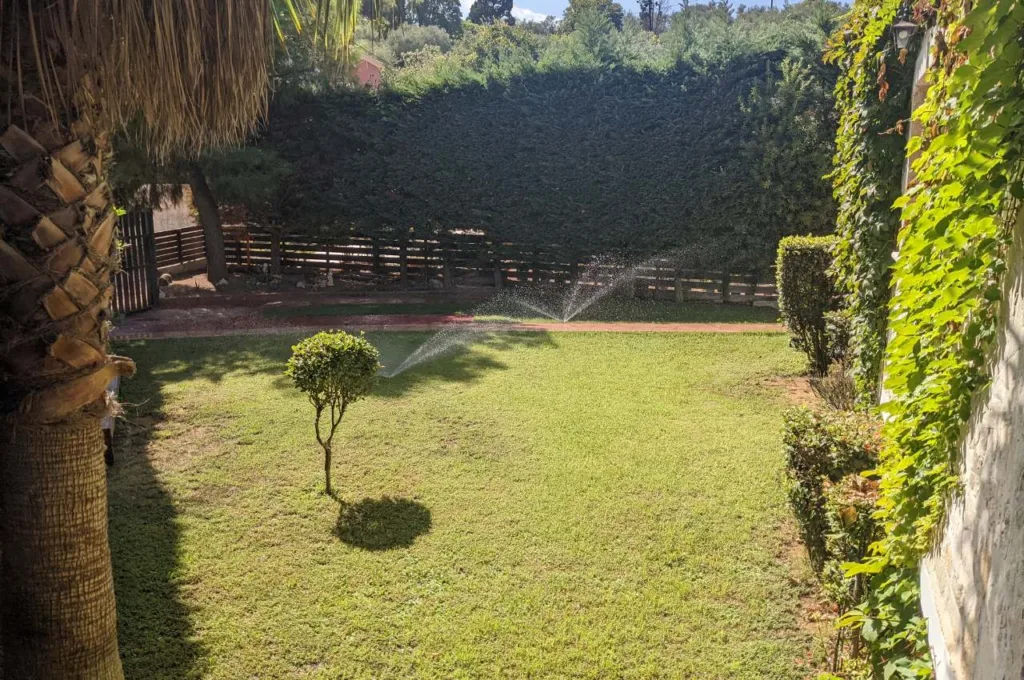
📏 Issue 3: Improper Planting Depth
If the depth of your planted grass seeds beneath the soil isn’t just right, that’s another possible cause of poor grass growth.
I’ve found that planting grass seeds too deep or too shallow can hinder germination. If the seeds are too deep, they’ll have limited access to sunlight and they may deplete their energy reserves because their path to the soil surface is longer. If the seeds are too shallow, they’re more likely to make a meal for your local wildlife, or they might simply blow or wash away.
How To Resolve:
In regards to seed depth, what has always worked for me is to plant grass seeds within 1-2cm of the soil’s surface.
The seeds need to be deep enough that they’re covered by loose soil rather than being on display for the birds. But they shouldn’t be too deep or they’ll struggle to grow.
🌱 Issue 4: Poor Seed Quality Or Old Seeds
Low-quality grass seeds may have a reduced germination rate, which may cause the grass to grow slowly or not at all.
The same goes for old grass seeds – most have a shelf life of about 5 years and will deteriorate around 10% each year. So if you’re using grass seed that you suspect is as old as your children, that’s probably why the grass isn’t growing.
How To Resolve:
Sometimes, you can’t avoid getting a bad batch of grass seeds. But you can avoid this issue by buying expert-recommended, highly-rated, fresh, high-quality grass seed from a reputable seller. I’ve shared my current recommendations for grass seed in my guide to the best grass seed of 2026.
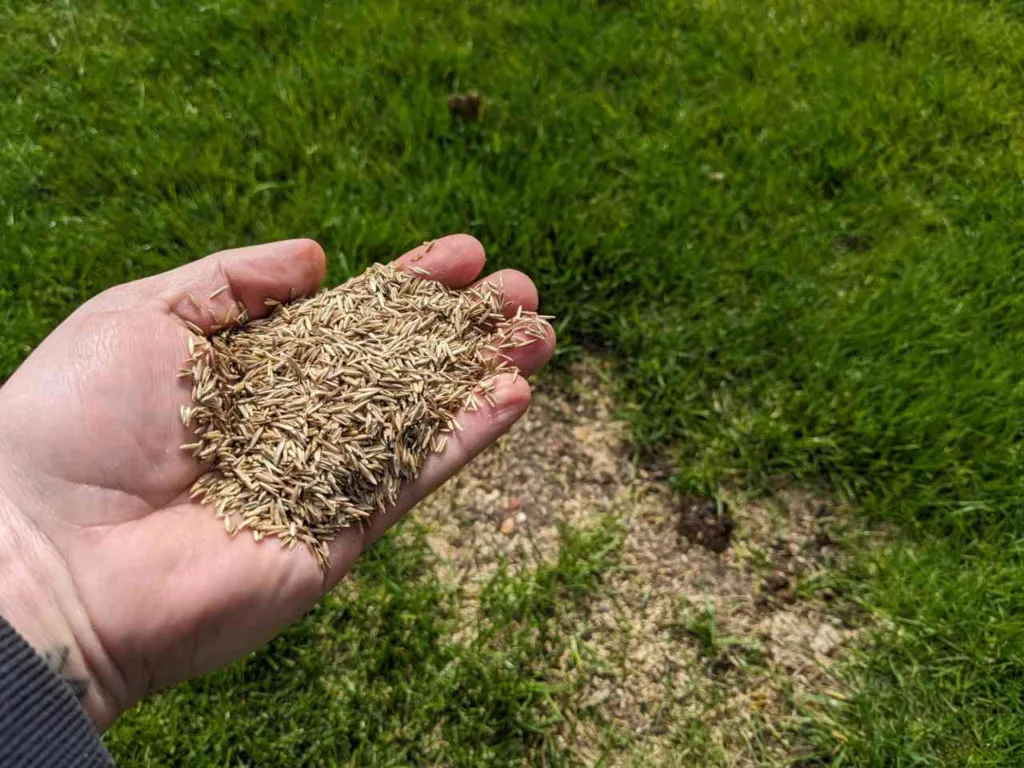
🗓 Issue 5: Incorrect Planting Time
Planting your grass seed outside of the growing season may prevent it from germinating – so you won’t see any growth.
My own experience tells me that the best time to sow grass seed in the UK is early spring or autumn, when the soil temperature is warm enough for grass seed to germinate rather than stay dormant. If you plant grass seed when it’s too cold, it simply won’t grow.
How To Resolve:
If your grass seed isn’t growing because you’ve sown it at the wrong time, unfortunately, you’ll probably have to admit defeat with your first attempt and try again when the weather is warmer.
As I mentioned above, early spring (around April-early June) and autumn (around mid-September-October) are the two best times to plant grass seed. Wait until the right time to sow your seed and you’ll get the best value from your purchase.
❄️ Issue 6: Environmental Conditions
On a similar note, extreme weather conditions, like drought, heavy rainfall, or frost can affect your grass seed’s ability to germinate and grow.
Drought will create challenges when it comes to water access, even if you’re regularly watering the ground. The soil will be so dry that the water will seep straight through. Heavy rainfall may wash away your newly sown seeds, meaning you see less growth because half the seeds are now down at the bottom of your garden. And frosty conditions are simply too cold for grass seed germination.
How To Resolve:
Trying to plant grass seed in the UK while navigating our hugely varied weather conditions can be challenging. My advice is to keep an eye on the weather forecast and sow your seed during a sunny spell of at least 2-3 days. Too much rain will wash away the seed, so it’s best to avoid rain during those early days of germination when possible.
You should also avoid planting grass seed during very hot, dry spells.If the outdoor temperature has exceeded 22-25°C and there’s no rain, it’s probably going to be too hot and dry to get the best results from your seed planting efforts, so wait for slightly cooler, damper weather before you get out your tools.
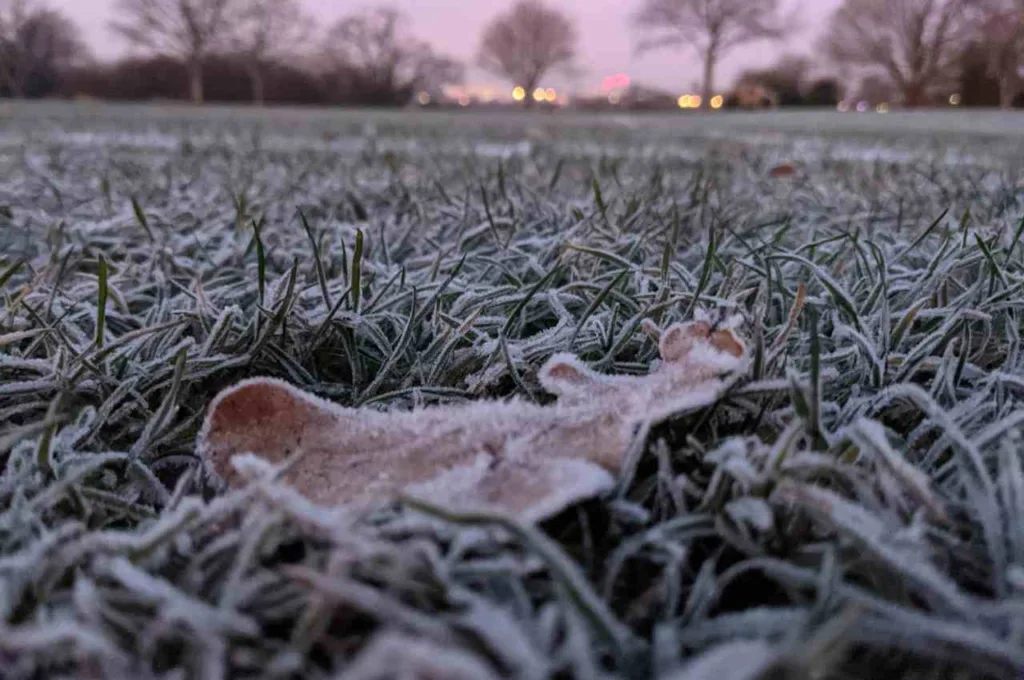
🍀 Issue 7: Competing Weeds
You’ll struggle to get good grass growth if you’re sowing seed on a weedy lawn.
I’ve seen first-hand how weeds can outcompete grass seedlings for resources, including sunlight, water, and nutrients. So if your lawn is a mishmash of daisies, dandelions, clovers, and even moss, these unwanted plants could be hindering new grass growth.
How To Resolve:
The first step to sowing grass seed on your existing lawn is to remove any competing weeds or weed seeds from the area. This is my best advice for preventing problems with grass growth due to competition from the greedier plants on your lawn.
My tip is to spot-treat weeds and pull them out of your lawn by hand where possible, making sure to get the entire root to prevent the weed from regrowing later. If you have moss, apply a combined lawn fertiliser and moss killer and wait a few weeks before sowing your grass seed.
Related: Why Is My Lawn Covered In Moss? How To Remove & Prevent Moss Regrowth
🐇 Issue 8: Pests and Diseases
Insects, birds, mice, and other animals will all try to get their claws, paws, and pincers on any possible food sources they can find in the environment – including your lawn’s new grass seed. If most of your lawn’s grass seed ends up being eaten by unwanted garden visitors, you’ll notice patchy or poor growth across your lawn.
Equally, some fungal diseases can damage or kill grass seedlings while they’re still in their vulnerable beginning stages of growth. Thankfully, this is a less common issue in the UK.
How To Resolve:
There’s little you can do about certain garden visitors, like birds and mice. I live across the road from an allotment and I’ve seen many a bird deterrent used over the years, from homemade scarecrows to reflective CDs and bottle cans, but nothing has worked with complete success.
Still, there are ways to stop birds and other wildlife from eating your grass seed, or at least make the seed less accessible or appealing to them. Covering the seed with topsoil, tempting wildlife with spare seed, and using netting and grow sheets to cover the seed are all methods I’ve seen the most success with.
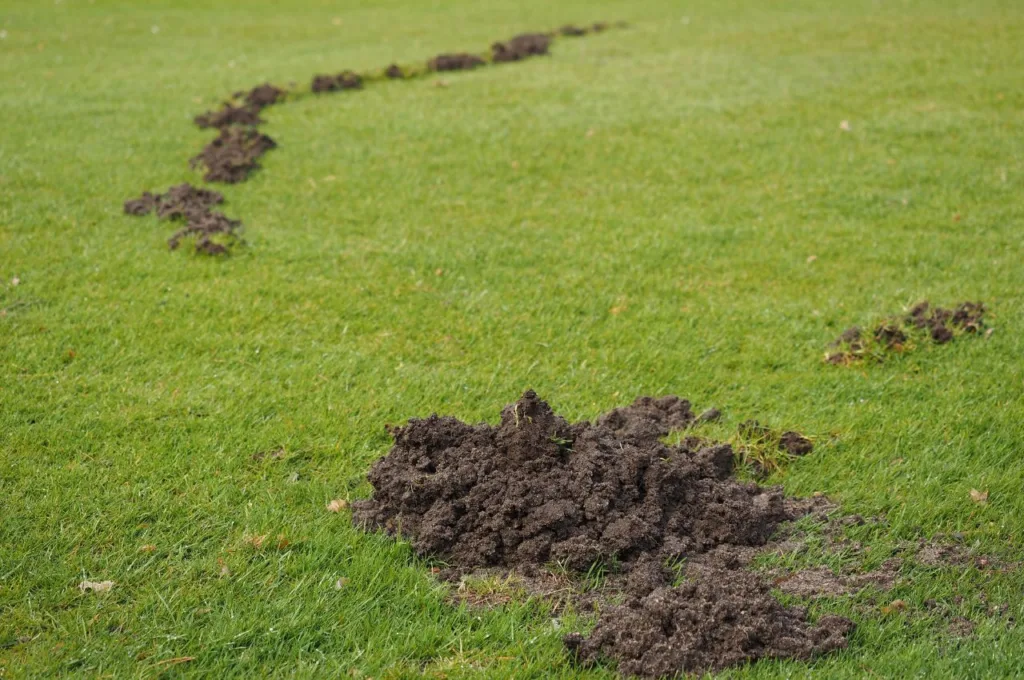
🧪 Issue 9: pH Imbalance
Grasses have preferred soil pH levels for optimal growth. If your soil pH is too acidic or alkaline for your grass to grow, it could be the reason why you’re not noticing any new growth.
Generally, grass prefers a pH of 5.5-7. Soil pH varies across the UK, and soil pH is generally lower in regions further away from the sea.
How To Resolve:
Luckily, most lawns in the UK have optimal soil pH for grass growth, so if you already have some grass in your garden, soil pH probably isn’t an issue.
But if you have any reason to be concerned, I recommend getting your soil tested to ensure it falls within the appropriate pH range for your chosen grass species. If it doesn’t, there are things you can do to adjust the soil pH – such as adding lime to make the soil more alkaline.
📈 Issue 10: Fertiliser Issues
It’s tempting to go heavy on the fertiliser after planting your new grass seed. After all, you want it to grow! But, as with many things in life, there is such thing as too much of a good thing when it comes to fertiliser use on your lawn.
Applying too much fertiliser can negatively impact grass seed growth by causing a rapid increase in the soil’s nitrogen levels, which can burn and kill the grass. Not ideal when you want to grow new grass – not kill the grass and other parts of your lawn while you’re at it. I’ve seen this happen to far too many people.
How To Resolve:
To resolve grass growth issues caused by over-fertilising, your only solution is to flush your lawn with water for a few weeks to wash away the excessive nutrients.
When using fertiliser in the future, make sure to follow the manufacturer’s recommendations carefully. I advise using a slow-release fertiliser, which will release its nutrients more gradually, if you’re worried about fertiliser burn on your lawn.
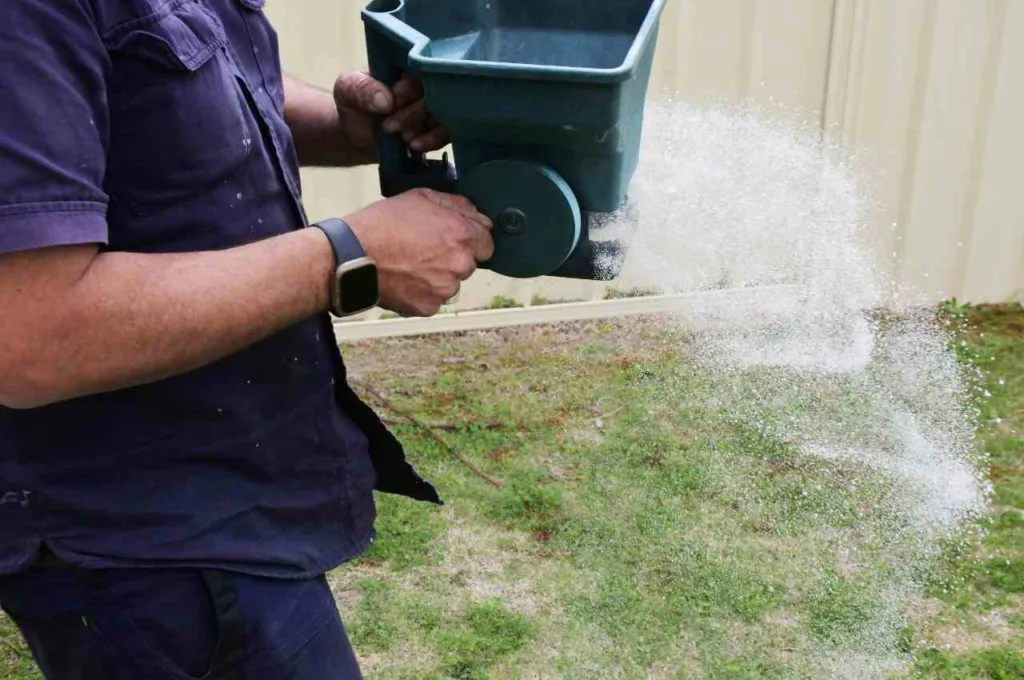
😤 Issue 11: Lack Of Patience
And finally, if you’re pulling out your hair wondering, “Why is my grass not growing?!” the answer might simply be that you need more patience.
Most grass seed manufacturers give you optimistic estimations for their seed germination timeframe, telling you you’ll see new growth within 7-14 days. But this is when the conditions are perfectly optimal for grass growth.
I’ve sown a lot of grass seed in my time, and I know it’s normal to wait up to 3-4 weeks before you start to see new grass poking through the soil – so have patience! There might be nothing wrong, and you simply need to wait a bit longer than anticipated.
How To Resolve:
As I said above, if a lack of patience is the problem, there are no issues with the grass, the environment, or the weather that you have to control. So my advice is simply to stick to a regular watering schedule and wait for the magic to happen.
If you’ve seen no new grass shoots within 5-6 weeks, contact the manufacturer – it’s possible that you’ve been given a bad seed batch.
🏁 Final Word
I made this guide because other guides on the internet don’t provide an extensive list of reasons why your grass might not be growing – both for existing lawns and newly-planted grass seeds. Hopefully, you were able to find what you were looking for in this article, and fingers crossed you can resolve your lawn growth problems using the above advice.
